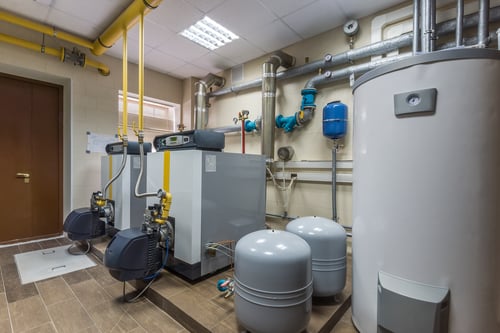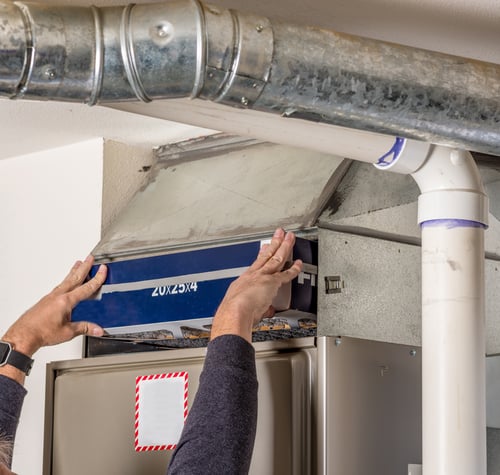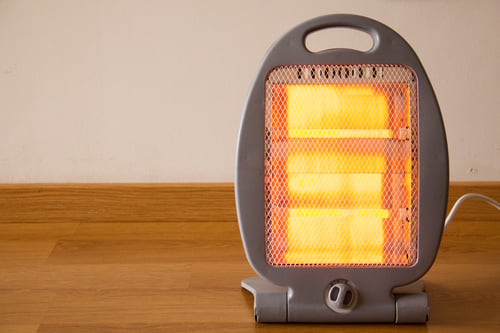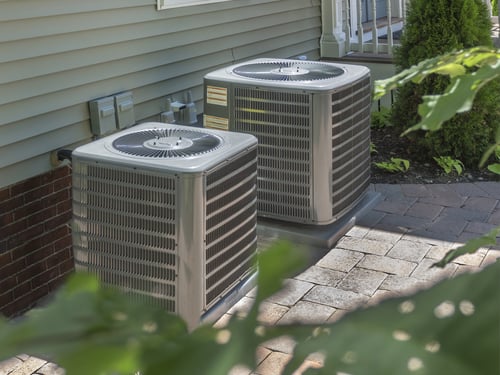The concept of a heating system is very broad and the term can be used to describe many different types of installations. Some heating systems use fuel combustion as a heat source, while others are powered by electricity. Another difference is the way heat reaches interior spaces; while some systems heat indoor air directly, others use an intermediate fluid like water or steam.
The most common types of heating equipment are boilers, furnaces, heaters and heat pumps. As with any engineering decision, each option has advantages and limitations.
Get an ideal heating system design for your construction project.
Boilers

Boilers heat a fluid that circulates through piping and the heat is then transferred from the fluid to the indoor air through heat exchangers. The fluid is typically hot water or steam – hot water provides heat through fan coils and steam provides heat through radiators.
In modern applications, hot water is considered the most economical heating fluid for boilers. Steam heating is viable when a building uses steam for purposes other than heating, such as manufacturing processes. When a boiler is only used for space heating, mechanical engineers will normally recommend hot water distribution.
Boilers can also be classified based on the fuels they use. Fuels differ in terms of cost and emissions, and the following are some examples:
- Natural gas is a common and economical boiler fuel. As it is delivered as a utility service, there is no need to schedule fuel delivery by truck.
- Heating oil is another common option in the Northeastern US. It is also an economical fuel, but has higher emissions than natural gas. Because heating oil must be delivered by truck, building owners must schedule deliveries to ensure they don't run out.
- Biomass is a viable boiler fuel when the homeowner has access to large amounts of organic waste that can be turned into biofuels. Biomass heating can be very expensive when biogas or biodiesel must be purchased from an external supplier.
- Propane is also used as boiler fuel. It must be delivered by truck like heating oil, but operates with greater efficiency and lower emissions.
There are also electric resistance boilers, but their operating costs can be very high, especially in places with expensive electricity. If you are considering an electric heating option to avoid fuel consumption, a geothermal heat pump can save over 70% compared to a resistance boiler, and an air source heat pump can save over 40% .
Ovens

Furnaces operate on the same energy sources as boilers, and as a result, the two types of equipment are often confused. The main difference is that furnaces heat indoor air directly, while boilers provide indirect heating with hot water or steam.
Furnaces are simpler and less expensive to install than boilers, but consider that heat is only provided with forced airflow. Water is a more effective medium than hot air over vertical distances, and hydronic piping is more compact than air ducts. Furnaces can also be noisy, as they require powerful fans to establish the necessary airflow.
In general, furnaces are more affordable than boilers and can be used in buildings with adequate provision for corresponding air ducts. When the building involves vertical distances and zoned heating, boilers are the recommended option.
Space heaters

Although boilers and furnaces are used in central heating systems, space heaters are a common option when areas of buildings require independent heating. Space heaters work like scaled-down furnaces, as they heat indoor air directly with fuel combustion or electrical resistance.
- Electric heaters are convenient and mobile because they use the building's power supply. Space heaters have a low initial cost but a high operating cost.
- Gas heaters are less expensive to operate, but require a gas supply. They must be properly ventilated, as closed combustion produces substances harmful to humans – carbon monoxide, in particular, can be lethal.
Heat Pumps

Heat pumps are modern devices that can achieve low operating costs, like combustion heaters, and at the same time have clean operation, like resistance heaters. A heat pump uses a refrigeration cycle, just like an air conditioner, but the direction of heat movement is reversed:
- In a heat pump, the refrigerant is expanded and evaporated to collect heat from outside the building and then compressed and condensed to release the heat inside.
- For comparison purposes, an air conditioner brings together internal heat with the expansion and evaporation of the refrigerant, to release it outside through compression and condensation.
Heat pumps can be described as either air source or ground source units, depending on the source from which they extract heat. While air source heat pumps (ASHP) are the most affordable, ground source heat pumps (GSHP) are the most efficient. However, both types of heat pumps are much more efficient than resistance heaters.
- Air source heat pumps are more affordable, but their effectiveness is reduced when outdoor temperatures reach the freezing range. The best models reach -20°C.
- Geothermal heat pumps do not have this limitation, as the ground temperature varies less than the air temperature throughout the year. However, they are more expensive.
Many heat pump models are designed for reversible operation, meaning they can be used as air conditioners during the summer. This way, you consolidate two mechanical systems into a single installation. However, it is important to ensure that the heat pump is reversible; some models only have heating mode and cannot be used as air conditioners.
Some heat pump models are designed to heat air directly, like furnaces, while others use hot water, like boilers. Heat pumps are also available in compact versions, similar in appearance to mini-split air conditioners.
Conclusion
There are many types of heating systems and the recommended equipment changes depending on the available budget and the building's needs. Furnaces and boilers are the conventional options, while heat pumps are emerging as a viable heating solution.
In general, combustion heating achieves a lower operating cost than electrical resistance heating, but heat pumps can often match the heating cost of fuels. When comparing furnaces and boilers, furnaces are typically the more affordable option, but boilers can adapt to more applications.

